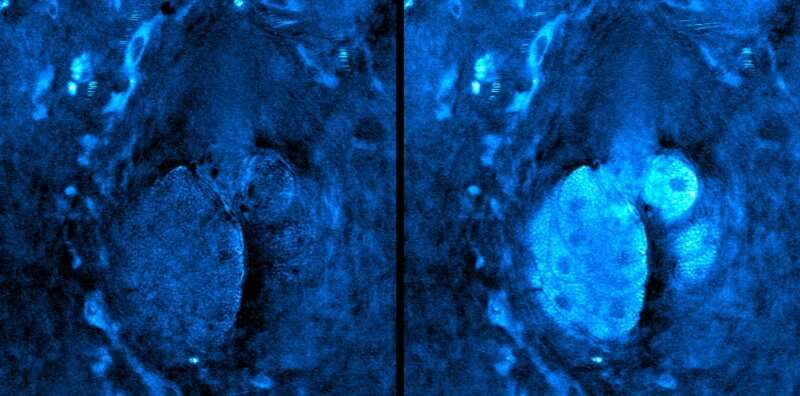To assess a cell's health, follow the glucose

A new spectroscopic technique reveals that glucose use in live cells provides valuable information about the functional status of cells, tissues, and organs. Shifts in a cell's use of glucose can signal changes in health and progress of disease.
How a cell uses glucose has long been a window on overall health. However, existing glucose-imaging tools have only been able to visualize early events in glucose metabolism, such as glucose uptake and distribution of small metabolites for energy production.
Now, scientists led by NIBIB-funded Wei Min, Ph.D., Professor, Department of Chemistry, Columbia University, NY, have developed an imaging technique that visualizes the metabolic dynamics as glucose is used to make downstream molecules, such as DNA, protein, lipids, and glycogen. The work is reported in the April edition of Nature Biomedical Engineering.
"Wei Min and his colleagues have combined sophisticated microscopy and computational methods to develop chemical imaging techniques that move us closer to identifying early changes in cells that lead to disease," explains Behrouz Shabestari, Ph.D., Director of the NIBIB Program in Optical Imaging and Spectroscopy.
"The goal of early identification of cellular changes that signal disease is to eventually be able to intervene clinically very early in a disease process—stopping that process in its tracks before damage to tissues and organs can occur," adds Min.
The group expanded on a technique known as Raman spectroscopy, in which a laser measures chemical vibrations that identify specific molecules in cells. The new technique is Spectral Tracing of Deuterium isotope (STRIDE). STRIDE works by following glucose that has been labelled with a a non-radioactive stable isotope of hydrogen called deuterium.
The team introduced deuterium-labelled glucose (D7-glucose) into cells in culture. They were also able to label mouse tissues simply by adding D7-glucose to their drinking water.
In live cells and in various tissues harvested from the mice, STRIDE allowed the researchers to follow D7-glucose and identify specific molecules that were synthesized, including lipids, proteins, and DNA. The technique allowed detection of the metabolic dynamics of these large molecules in a variety of mouse organs including brain, intestine, liver, and fat.
The authors state that the high-resolution assessment of glucose use provided by STRIDE is a significant step towards meaningful analysis of cellular states of health and disease. The team is now working to use STRIDE with an endoscope that would allow analysis of tissue health during examinations such as in endoscopy of the esophagus and other organs.
More information: Luyuan Zhang et al. Spectral tracing of deuterium for imaging glucose metabolism, Nature Biomedical Engineering (2019). DOI: 10.1038/s41551-019-0393-4




















